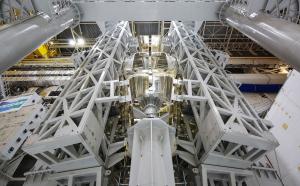Practising the embrace
Procured by Korea, the vacuum vessel thermal shield fits between the vacuum vessel and magnetic system of the machine and act as a barrier against the transfer of heat to the ultra-cold superconducting coils.
The outboard segments were mounted last month on the "wings" of the sector sub-assembly tool and measured; now, the wings are being rotated inwards ... the ultimate test of the fit of the two components.
Hydraulic cylinders located at the base of the tools urge the rotating platforms forward in the toroidal direction in a "push and clamp" motion. As they approach the suspended vacuum vessel sector, actuators on the rotating platforms permit the components to be positioned with the highest accuracy and adjusted to six degrees of freedom (up and down, side to side, forward and backward, swivel, tilt, and pivot).
Click here to view a time-lapse video of the fitting test.


